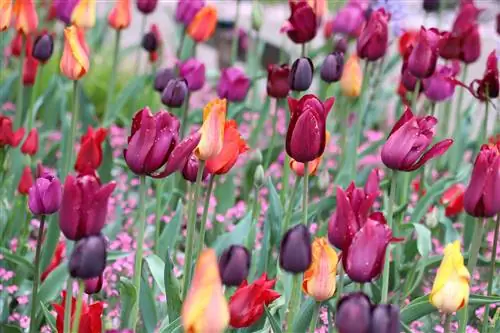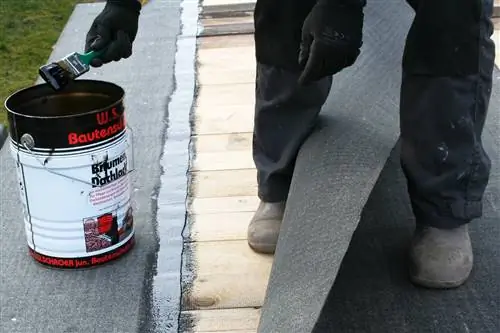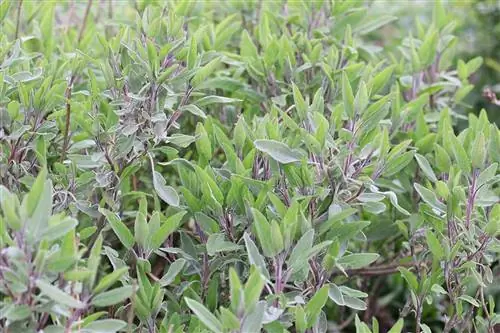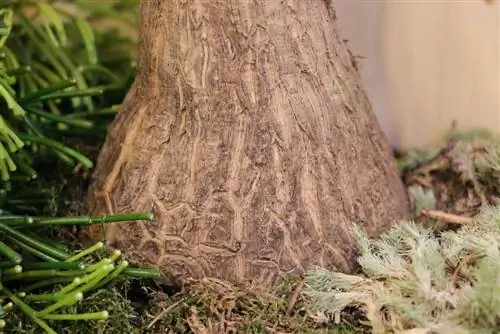- Author admin [email protected].
- Public 2023-12-17 03:39.
- Last modified 2025-06-01 06:48.
Pink to purple flowers in abundance, a gentle scent and an impressive size - the clary sage can delight in many ways and is a wonderful addition to the terrace and bed. However, there are a few points to consider when caring for the two-year-old plant. If the special, albeit low, requirements are met, the plant can even provide enjoyment for more than two years. What interested hobby gardeners need to know can be found here.
Location
The clary sage can reach a height of up to 1.5 meters. This is only in the second year after germination, but the impressive height should still be taken into account when choosing the location. This should also be protected so that the plant does not have to endure cold winds. The planting site must also be warm and sunny.
Substrate
Loamy or humic - the main thing is that it is permeable. Clary sage does not tolerate waterlogging and suffers from wet soil, especially in winter. Dense soil or soil that tends to compact should therefore be loosened up with sand. Apart from that, Salvia slarea thrives on almost any substrate.
A mixture of garden soil, compost and sand is optimal. Loose potting soil also serves the purpose.
Watering and fertilizing

After sowing or planting, the clary sage is watered and initially kept slightly moist. As soon as it has grown or formed roots, it can usually take care of itself in the bed and only needs additional water during prolonged dry periods. It's different in the bucket, where it still needs to be watered. It is always important to ensure that the substrate dries at least superficially between waterings. Rainwater or stale tap water is ideal for watering clary sage. Untreated pond water can also be used. If the clary sage has been planted in fresh soil or, if necessary, compost-enriched soil, additional fertilization can be avoided during its usually two-year life cycle. If growth is weak, the Salvia sclarea has sown itself or the soil is used up, herbal fertilizer can be applied in early summer. Alternatively, fertilization with plant manure, the pond water already mentioned or compost is also possible. It is also possible to fertilize the clary sage repeatedly in late summer. However, the last date should be at the beginning of September.
Blend
The clary sage does not bloom in its first year and has a rather inconspicuous appearance. In the second year it grows to full size and shows numerous flower spikes. The plant usually dies afterwards. Salvia sclarea does not need to be pruned during its life or directly after flowering. On the one hand, the flowers and panicles that fade after they die are still extremely decorative. On the other hand, seeds for the next generation can only be obtained from them. That being said, clary sage does not grow stronger or more densely branched when it is cut. The measure is therefore unnecessary. However, corrections can certainly be made to control the size or remove damaged parts of the plant. The extraction of tea or herbs is also possible without any problems throughout the entire growth process.
Wintering

The clary sage is hardy down to around -15°C. However, it can die in harsher winters or when the ground is wet. It therefore makes sense to protect it accordingly. The most important prerequisite is of course a protected location. A layer of mulch, straw or brushwood serves as additional insulation. However, it would be optimal not to sow the clary sage directly into the bed or to plant it there in the first year. Instead, culture in a container is recommended during the first year. It is not planted until the spring of the second year. This way it can be safely overwintered indoors in a bucket. It should be kept cool but frost-free. Temperatures of a maximum of 10°C are favorable. The substrate must not dry out completely during the winter, but it must not be wet either. So water is used sparingly. Fertilization is completely avoided.
Propagation
The clary sage reproduces itself in which the seeds contained in the flowers sow automatically. Of course, the flowers must not be removed immediately after they die, but must remain in place until the following spring. However, this variant of propagation is untargeted and therefore basically only suitable for natural gardens. If you want to prevent self-sowing, you should remove the flowers after they have bloomed or in early spring.
Tip:
Fabric bags placed over the flower spikes catch the seeds and thus make the seeds available for a new generation and targeted sowing.
Planting and sowing
Cly sage can only be propagated by seeds. If you want to save yourself this work, you can also purchase young plants commercially. These can be planted outdoors either in spring or early summer after the last frost. Late summer or early fall are also possible. However, the risk of frost damage is then comparatively high. It is ideal to cultivate Salvia sclarea in a pot during the first year and only then to plant it outdoors. It must be ensured that the plant is not planted deeper than it was previously in the container. In addition, the substrate should be well moistened, but water drainage should be ensured. However, the following procedure is recommended for sowing:
- The time chosen is April or May when the temperature is between 15° and 20°C.
- The seeds are sown in groups of three to five at a distance of 30 to 40 centimeters and lightly covered. For a more widespread result, the seeds can also be scattered. However, it then becomes necessary to prick out the seedlings.
- To avoid washing away, the soil should be well moistened before sowing. The soil is kept slightly moist until germination.
- After germination, which occurs about two to three weeks later, watering is gradually reduced.
- When the plants reach a height of ten centimeters, the weaker plants are sorted out and removed.
Tip:
Sow the clary sage every year and staggered, this way you don't have to miss out on the flowers and bee pasture.
Culture in a bucket
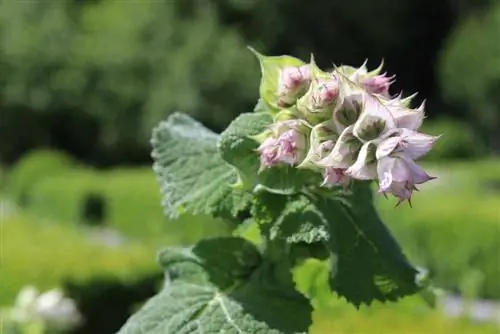
If you decide to grow clary sage in a bucket, you don't have to pay much attention to it. Only more frequent watering and additional fertilizing should be taken into account.
Conclusion
Clary sage is a fairly easy-care plant that can be left largely to its own devices in the right location. Neither cuttings nor fertilization nor complex winter protection are necessary. This makes Salvia sclarea ideal for natural gardens and anyone who wants to bring beauty into the green oasis without much effort and care.


